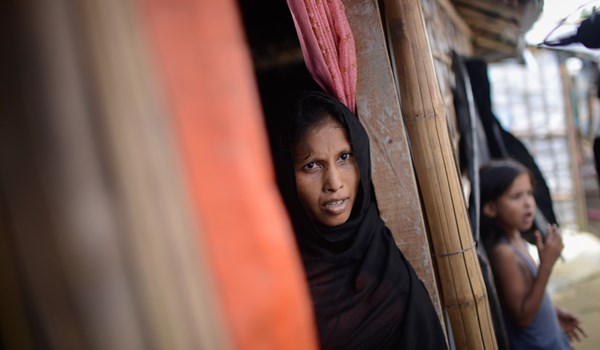
Several Rohingya, who did not want to be named, told Al-Jazeera that men, women and even children were “beaten with sticks” by Bangladeshi naval officers after they went on a four-day hunger strike last month.
Photographs of men wounded by the beatings were provided to Al-Jazeera by Rohingya activists who did not want to be named, fearing official retribution.
“Listen, there is no one here that is happy with the living conditions. We are not given enough food to eat, we don’t have clothes to wear, we don’t have phones. We have nothing,” said one Rohingya who wished to remain anonymous.
Bangladesh last year constructed facilities for 100,000 people on Bhashan Char, a muddy silt islet in the cyclone-prone coastal belt in the Bay of Bengal, saying they needed to take the pressure off crowded camps that are home to nearly a million Rohingya.
The mainly Muslim Rohingya live in sprawling refugee camps in Southern Bangladesh, most having arrived from neighbouring Myanmar in late 2017 after fleeing a military crackdown that the United Nations said was conducted with genocidal intent.
In a bid to curb the spread of coronavirus in the crowded camps, more than 300 Rohingya were transported to Bhashan Char in May after they tried to escape to Malaysia on a boat.
But those on the island told Al-Jazeera that living conditions were deplorable because of insufficient food and water.
“We didn’t eat for four days because we want to get out of here. We went on a hunger strike, but they forced us to eat and beat us so much. They beat the young women, too. Their violence was worse than the Burmese [Myanmar] military, even they never beat us this badly,” one man, who stated he wanted to be reunited with his family in the mainland Kutupalong camp, told Al-Jazeera.
A witness told Al-Jazeera that men, women and children, “whoever came in their way were beaten”, while another called the island a “prison”.
“Some of us are sleeping on the concrete floor and there are no covers for sleeping. We are given little food and the water for bathing is making our skin itch and causing eczema,” he added.
Describing the hunger strike, a Rohingya witness told Al-Jazeera that participants “refused to eat the food” or meet “the bosses” when “ordered” to do so.
“We refused to go. Then they came for us. We locked ourselves in but they got into the building and beat us. They said we have to eat the food and we cannot do as we please because they are in charge,” he noted.
The Rohingya announced children as young as four were also on the hunger strike, adding, “Even the children told the officials they will not accept food until they know we can all return to Kutupalong, but they were forced to eat.”
Kutupalong is one of the largest Rohingya camps located in Cox’s Bazar district of Bangladesh.
Brad Adams, Asia director of Human Rights Watch, called on authorities to “allow United Nations experts to conduct an independent assessment of the island and to ensure that any relocation there is voluntary”.
“In a darkly ironic attempt to portray Bhasan Char as a safe location, Bangladesh authorities beat Rohingya refugees, including children, who were protesting their detention and begging to return to their families in Cox’s Bazar,” he said in a statement last week.
Out of the 306 refugees on the island, there are 30 children, 97 men and 179 women, according to the witnesses.
“We have been here for more than five months. There is no school, no mosque, nothing. There is nothing here. They don’t let us go anywhere. We stay in our rooms to eat, sleep and pray,” said a witness.
“The bosses are telling us we have to stay here because this place has been made for us, and they will bring more people from Kutupalong camp to stay here,” he added.
Unlike the mainland Rohingya camps, there are currently no NGOs or UN refugee agency personnel on Bhasan Char island.
But UNHCR Spokeswoman Louise Donovan told Al-Jazeera the UN has informed Dhaka it is “prepared” to visit the island to assess the humanitarian situation.
She stated it is “now urgent for the UN to have access to the Rohingya” and in light of reports of abuse on the island, “it is even more urgent that the UN protection visit to Bhasan Char can go ahead as soon as possible in order that we can interview the refugees directly”.
Last month, a group comprising 40 Rohingya “leaders” visiting Bangladesh, was sent to Bhashan Char to assess the facilities on the islet, but London-based journalist and filmmaker Shafiur Rahman noted such steps were “simply PR [public relations]”.
Rahman told Al-Jazeera he spoke to members of the Rohingya group about impressions of their trip to the island, stating that one person told him “It is better to go to Myanmar than this island”.
He said another member of the group added, “Even if we don’t have a roof in Myanmar, we will manage. We don’t want to live inside a golden cage. Our dream remains to go back to our land. Give us our land back.”
The Bangladesh Navy and Office of the Refugee Relief and Repatriation Commissioner did not reply to Al-Jazeera’s request for a response to the allegations by the time of the publication of this article.

No comments:
Post a Comment